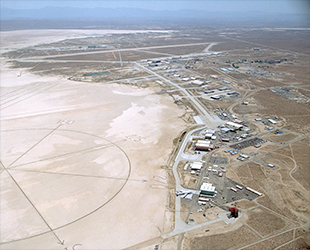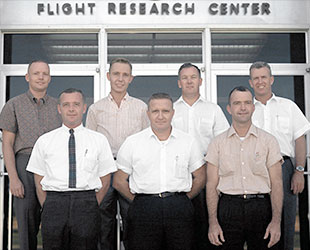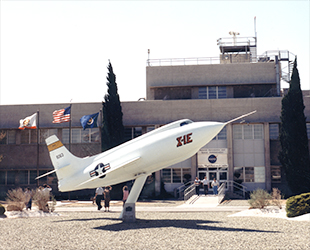Jan. 9, 2014 – Lawmakers have renamed NASA's primary flight research center to honor the first man to walk on the moon.
The U.S. Senate on Wednesday (Jan. 8) passed a bill that redesignates the space agency's Dryden Flight Research Center in southern California the "NASA Neil A. Armstrong Flight Research Center."
The legislation continues to honor the facility's displaced namesake by renaming the surrounding area the "Hugh L. Dryden Aeronautical Test Range."
The U.S. House of Representatives earlier introduced and passed a corresponding resolution in February 2013. This was at least the third time since 2007 that Congress has sought to name the flight research center for Armstrong.
On Thursday, the bill was presented to the President to be signed into law.

Aerial photograph of NASA Dryden Flight Research Center, which Congress voted to rename for astronaut Neil Armstrong. (NASA) |
In July 1969, Armstrong and his Apollo 11 crewmate Buzz Aldrin landed on the moon, where Armstrong became the first human in history to set foot on the lunar surface.
Armstrong, 82, died Aug. 25, 2012 following complications resulting from cardiovascular procedures.
"Neil Armstrong turned dream into reality by making that 'one small step for a man, one giant leap for mankind' on another world almost 240,000 miles away," Congressman Lamar Smith (R-Texas), one of the bill's eight co-sponsors in the House, said last year.
Prior to his becoming an astronaut, Armstrong served as a research pilot flying out of the center that will now bear his name.
From 1955 to 1962, Armstrong served as an experimental test pilot at the then High-Speed Flight Station, amassing 2,400 hours of flying time, including flying the X-15 rocket plane. While still at the station in the early 1960s, he was part of the team that conceptualized the Lunar Landing Research Vehicle, which helped create the training vehicle that later he and other Apollo astronauts used to practice landing on the moon.

Neil Armstrong (at top left) was one of seven test pilots at NASA's Flight Research Center when this was taken in 1962. (NASA) |
"In some respects, I think Neil might have been a happier man if he had stayed a test pilot, becoming chief test pilot at NASA Dryden," historian James Hansen, the author of Armstrong's 2005 authorized biography "First Man," said. "His career in test flying will be remembered even more now that his name will be forever associated with the flight research center."
The center, located at Edwards Air Force Base, is NASA's premiere facility for atmospheric flight research and flight operations. In addition to its work to advance the design of civilian and military aircraft, the center was designated the primary alternate landing site for the space shuttle and is now managing launch abort system testing and integration for NASA's Orion crewed spacecraft.
The center was originally known as the Muroc Flight Test Unit under NACA, the aeronautics predecessor to NASA. The facility was also referred to as the High-Speed Flight Research Station and High-Speed Flight Station prior to it becoming a part of the space program with the founding of NASA in 1958.

The main building at Dryden Flight Research Center at Edwards Air Force Base, Edwards, Calif., as seen in May 1999. (NASA) |
On March 26, 1976, the flight research center was named in honor of Hugh L. Dryden, the former director of NACA, who served as NASA's first deputy administrator up until his death in 1965. One of the country's most prominent aeronautical engineers, Dryden helped shape policy that led to the development of the nation's high-speed research program and its record-setting X-15 rocket plane. He also headed the negotiations for the early agreements with the Soviet Union on the peaceful use of space.
"Dryden recommended to President John F. Kennedy that the goal of putting a man on the moon within 10 years was achievable and something the American people could rally behind," Smith, who serves as the chairman of the House Committee on Science, Space and Technology, said in a February 2013 statement. "Dryden was not able to see his dream become reality, as he died in 1965."
"Neil Armstrong was the one who flew the spacecraft that Dryden envisioned," Smith said.
